Manage Providers
In This Article
List Providers
-
Click the Providers menu and select List Providers. The List Providers window opens.
-
Click the Filter Providers By drop-down menu and choose from the following:
-
Active: List providers who are currently enrolled and claiming with your sponsorship. Providers set to Hold status also appear in the resulting list.
-
Active and Withdrawn After: List active providers and those who have been withdrawn after a certain date. If you select this option, click the corresponding Date box and enter the date (MM/DD/YYYY). This option also adds a Removal Date column to the resulting provider list.
-
All: List all providers, regardless of status. If you select this option, a Removal Date column is added to the resulting provider list.
-
Hold: List only those providers whose current status is Hold.
-
Withdrawn Before: List only providers who have been withdrawn before a certain date. If you select this option, click the corresponding Date box and enter the date (MM/DD/YYYY). This option also adds a Removal Date column to the resulting provider list.
-
-
Click Search For Providers Where to set additional filters. Click each box and enter the information by which to limit. Click Search Tips for helpful information about using these search options. Click
 to clear the text you've input in these boxes.
to clear the text you've input in these boxes. -
When finished, click Refresh List. The providers most closely matching the criteria you specified display.
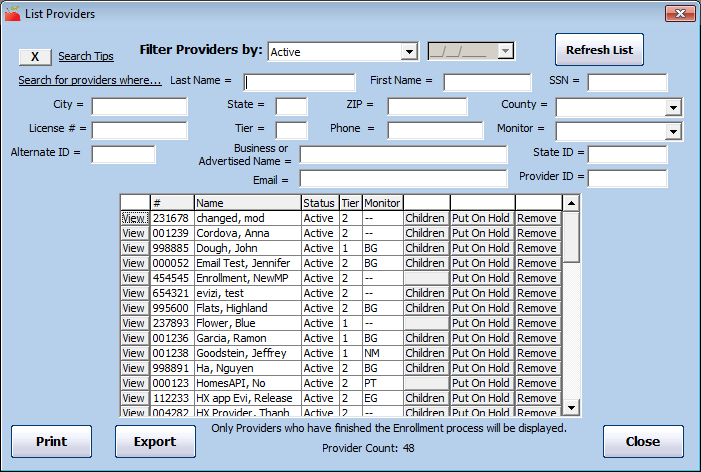
-
Click the #, Name, Status, Tier, or Monitor column to sort information in ascending or descending order by that column. for example, if you click the Tier column, the providers are sorted by Tier status.
Note: The Status column sorts providers in the following status order: Active, Hold, Pending, and Removed. The Status header is not visible if you filtered by Hold or Withdrawn Before.
-
You can do the following in this window:
-
Click Print to generate and print the List Providers Report.
-
Click Export to export the Provider List Export File. This is an XLSX file. You can use a spreadsheet program, such as Excel®, to further sort and manipulate the data.
-
Click View to open the Provider Information window for a specific provider.
-
Click Children to open the List Child window for the selected provider.
-
Click Put On Hold/Take Off Hold to change the provider's hold status. For more information, see Place Providers on Hold.
-
Click Remove to remove the provider. For more information, see Remove Providers.
-
Click Reactivate to reactivate a removed provider. For more information, see Reactivate Providers
-
Update Provider Information
Once you enroll providers, you can update them at any time in the Provider Information window.
-
Click the Providers menu and select Provider Information. You can also click the Provider menu, select List Providers, and click View next to the provider to change. The Provider Information window opens.
-
Click the Provider drop-down menu and select the provider to change.
-
Click each box to change and enter new information over the existing information. You can change information in each of the tabs.
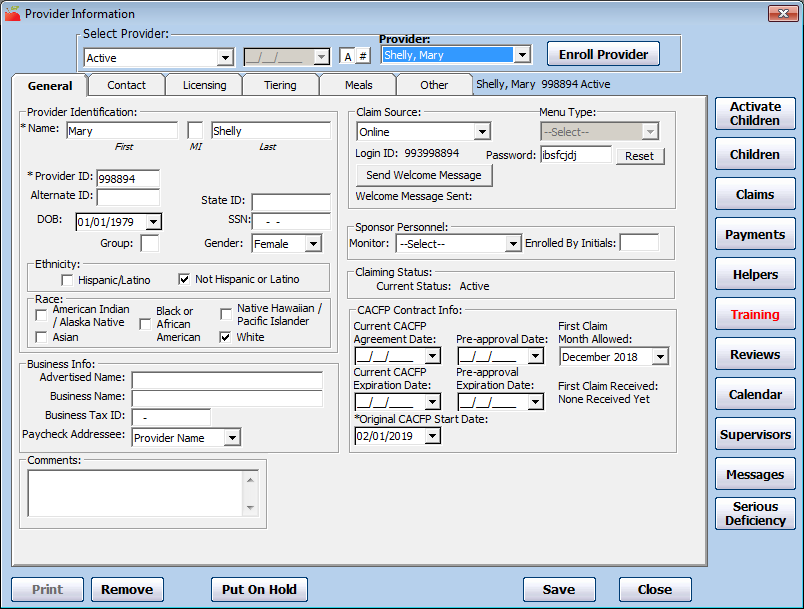
-
When finished, click Save.
Bulk Provider Update
Use the Bulk Provider Update function to update information for multiple providers at a time. For example, you can update tier eligibility or CACFP agreement dates.
-
Click the Administration menu and select Bulk Provider Update. The Provider Filter window opens.
-
Set filters for the providers to include in the change. Check the Choose Providers From List box to select specific providers from a list.
-
Click Continue. If you did not check the Choose Providers From List box, the Bulk Provider Update window opens. Go to Step 5.
-
If you choose to select providers in Step 2, the Choose Providers dialog box opens. Check the box next to each provider and click Continue. The Bulk Provider Update window opens.
-
Check the box next to each item to update. You can update the following: Claim Source, Provider Status, CACFP Agreement Date, Income Eligibility, License Start Date, License End Date, or Census Eligibility.
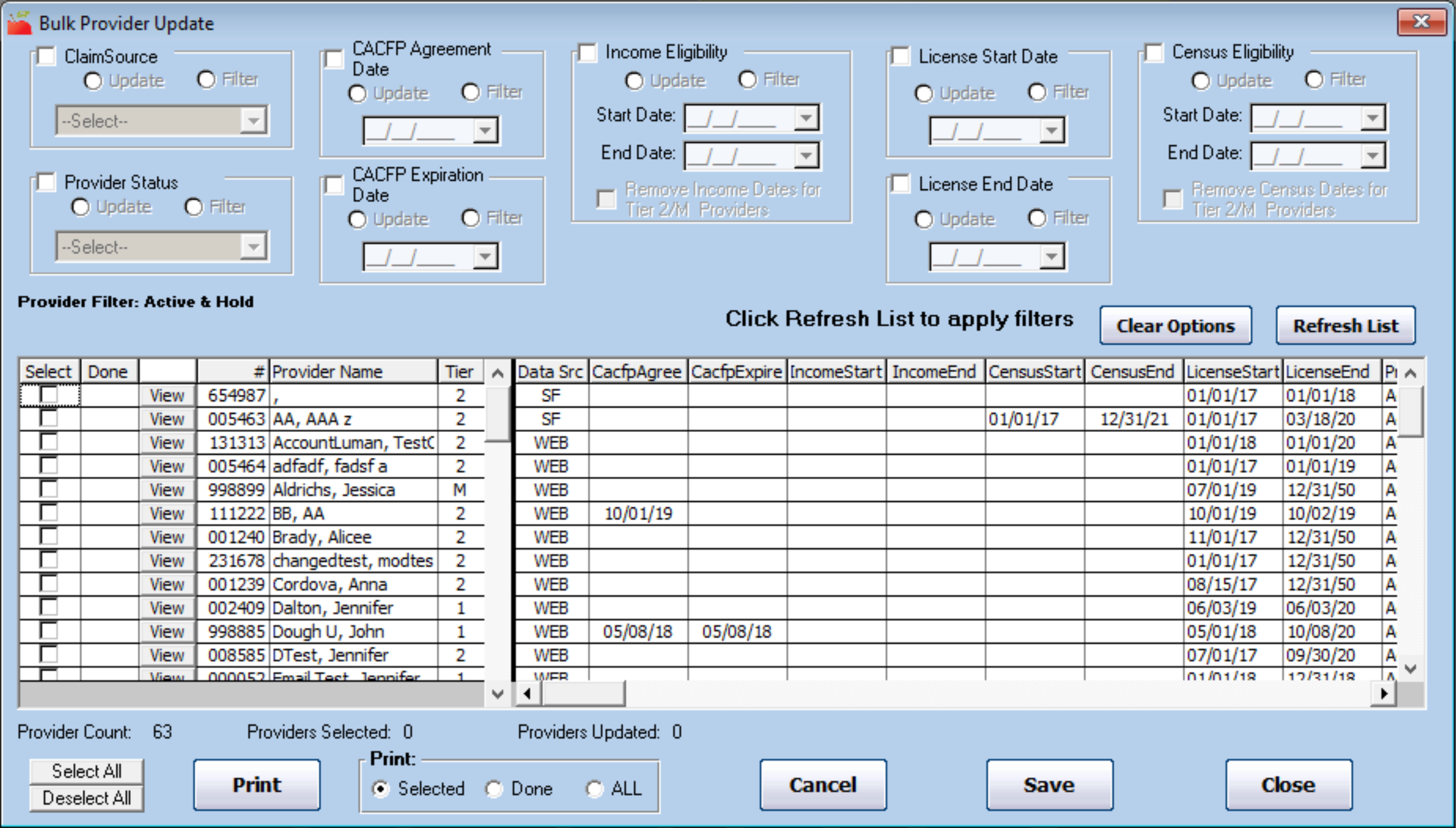
-
Set new dates, as needed.
-
Check the box next to each provider to which to apply these changes.
-
Before saving your changes, click Print to print a report that lists all providers you are updating and their current information. Review this report carefully and confirm that you have selected the correct providers. You cannot reverse this process once its complete.
-
Click Save.
Manage Provider Capacity
The Provider Information Licensing tab allows you to record virtually all aspects of information related to the provider's capacity. Minute Menu HX uses capacity information when processing KidKare claims, scannable form claims, or Direct Entry claims. If you review claims manually, this information is also available on certain reports for you to use as a benchmark.
Minute Menu HX does not check capacity on manually entered claims.
Each state handles capacity in different ways, and each state also handles capacity checks in different ways for different types of family child care home licenses or registrations.
For some licenses/states, the allowed capacity at any given meal is fixed and cannot be varied for individual providers. If this is the case, then you cannot change the capacity for individual providers and are given a Maximum Capacity value when you select the provider's license type.
For other licenses/states, the allowed capacity is more flexible. This means you can change the maximum allowed capacity for individual providers. You can also typically set a maximum capacity for infants, as well as a maximum overall capacity. If this is the case, you can see two boxes in the Licensing tab: one allowing you to enter an infant capacity maximum and one for a school-aged (overall) capacity maximum. Therefore, change the numbers in these boxes to vary the capacity.
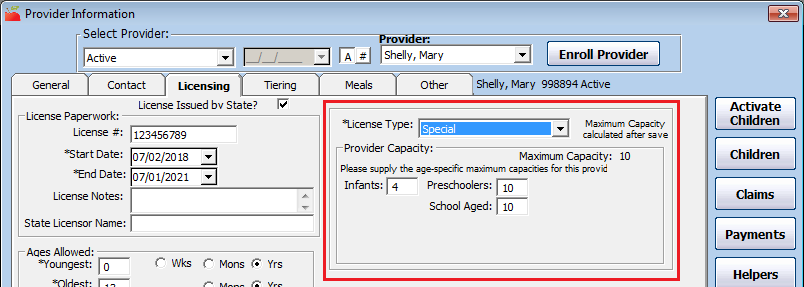
Still other states/licenses vary the allowed capacity based on the specific meal served. If this is the case for you, then you will see each of the six meal listed, which allows you to supply a maximum capacity just for that meal.
Waivers
Capacity waivers are allowed in certain states/for certain licenses. When a waiver is in effect for a provider, that provider is exempt from over-capacity errors. Waivers typically have start and end dates, and you must supply such dates when you indicate a waiver is in effect. If a waiver only applies when a particular child is in attendance, you can indicate that the waiver is child-specific and then specify the appropriate child. You can also enter a description.
To set a waiver:
-
Click the Providers menu and select Provider Information. The Provider Information window opens.
-
Click the Provider drop-down menu and select the provider to change.
-
Click the Licensing tab.
-
Check the Waiver box.
-
Click the Start Date and End Date boxes and set a start and end date for the waiver, if required.
-
If this waiver is child-specific, check the Child Specific box. Then, select the child to which the variance applies.
-
Enter any description, as needed.
-
Click Save.
Variances
Capacity variances are allowed in certain states/for certain licenses. When a variance is in effect for a provider, that provider's capacity is increased or decreased by the amount you enter.
-
Click the Providers menu and select Provider Information. The Provider Information window opens.
-
Click the Provider drop-down menu and select the provider to change.
-
Click the Licensing tab.
-
Check the Variance box.

-
Click the Start Date and End Date boxes and enter a start and end date for the variance.
-
If this variance is child-specific, check the Child Specific box. Then, select the child to which the variance applies.
-
In the Please Enter the Specific Amount(s) to Increase Capacity By section, click each box that applies and enter the amount by which to change the capacity.
-
Increase Capacity: Enter a positive value in the specific age category.
-
Decrease Capacity: Enter a negative value in the specific age category.
-
-
Click Save.
Manage Provider Tiering
You record a provider's Tier and Tier qualifying information in the Provider Information Tiering tab. This information is essential, as it determines reimbursement rates for the provider.

-
Tier: A provider's tier can be set to the following:
-
2: Providers are set to Tier 2 by default, unless you specify otherwise. If you select Tier 2, you can set a Tier 2 effective date, which can be useful in certain states to record when you attempted to verify the provider's tier (even though they don't qualify).
-
1: Select Tier 1 if the provider meets school, income, or census requirements for Tier 1 reimbursements. This means that all children enrolled with this provider should be reimbursed at Tier 1, even if the children themselves are not set up as Tier 1 Income Eligible. Note that this does not guarantee that claims will be reimbursed at Tier 1. The qualifying dates in this tab must be valid (see below).
-
M: Select M if the provider is Mixed-Tier. This means that the provider is not Tier 1, but they have children enrolled who are Tier 1 income Eligible.
-
-
Income Eligibility: If the provider is Tier 1 by Income, click the Start Date and End Date boxes and enter the starting and end dates for this qualifying status. Once these dates expire, the provider will be automatically reimbursed at Tier 2 rates unless the dates have been updated prior to the reimbursement being issued. However, the Tier drop-down menu remains set to 1 until you actively change it. End dates are inclusive, which means that if you set the End Date to June 30th, the provider is treated as Tier 1 on June 30th.
-
Food Stamp Eligible: If a provider is categorically eligible for Tier 1 because they are Food Stamp participants, you must supply Income Eligibility Dates and you must also indicate that the provider is Food Stamp Eligible. Check this box. Then, click the Case Number box and enter the provider's food stamp case number. The Start/End dates are required by some state agencies. This information prints on the Provider List Export File when you report this information to your state agency.
-
-
Schools: If the provider is Tier 1 due to the poverty percentage at the nearest school(s), click Add School and enter school eligibility information. Note that Minute Menu HX only examines Start and End dates by default when determining tier eligibility. However, HX can be configured to examine the poverty percentages. Check your Sponsor Preferences. You must provide start and end tiering dates as follows:
-
In states where Minute Menu HX has the state's school tiering list in electronic format, a list of schools displays. Select the school area that applies to this provider. The relevant information (poverty percentage, etc), populate the remaining fields automatically. When you enter the tiering start date, the end date automatically defaults to five (5) years after the start date. Save your changes. You can add additional schools for which the provider qualifies.
-
In these states, you should assign every provider to the closest school(s), even if that school area does not qualify for Tier 1 reimbursement. Leave the dates blank for each area in which the school does not qualify. If you have assigned every provider to a specific school, you can run the School Tier Comparison report each year when new rates are released by your state. This report lists any providers who used to be Tier 2, but whose school area now qualifies due to the school area's poverty threshold. Using this information, you can reassign provider tiers as appropriate.
-
-
If your state does not have school data in the Minute Menu HX database, you must manually enter all information for each school area that applies to the provider. Click Add School and enter the required information. You can add additional schools for which the provider qualifies.
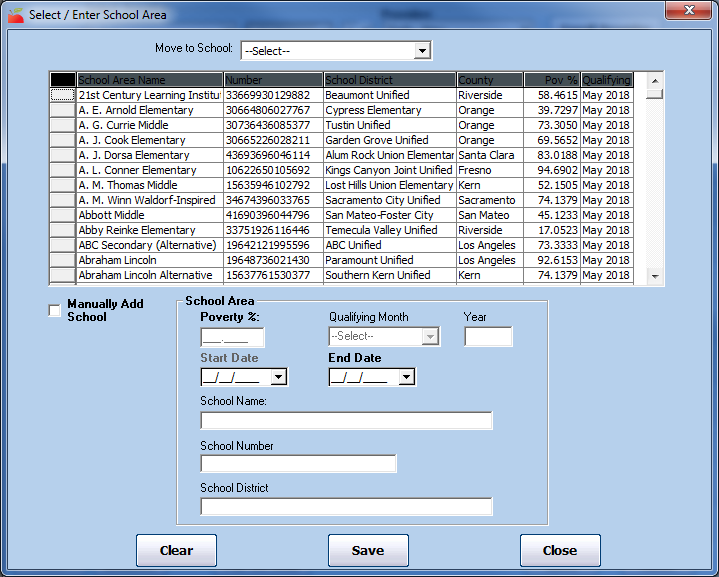
-
-
Census District: If the provider is Tier 1 eligible due to census district, enter Start and End dates in the Census District section. You can also complete the Census District and Census Poverty % boxes, but these are optional, as Minute Menu HX only examines eligibility dates. End dates are inclusive, which means that if you set the End Date to June 30th, the provider is treated as Tier 1 on June 30th. You should always enter Tier 1 Census Eligibility, even if the provider qualifies for Tier 1 by another means.
-
Your agency can be configured to pull the Census Block from a list (all census blocks are coded into Minute Menu HX by default). If you've enabled this feature, the Change Census Area button displays. Click it to choose the provider's census block from a list. The eligibility percentage will be automatically filled-in for you.
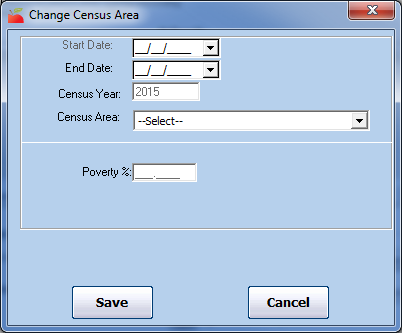
-
Click Lookup to access a website created by FRAC that will identify the census block of the provider an indicate whether that census block is Tier 1 or not.
-
Enter any special comments or notes in the Tier comments box. This information is for your own use only and has no effect on the provider's claim processing. You can enter up to 255 alphanumeric characters in this box.
Remember to save your changes before exiting this tab.
Manage Historic Provider Data
Provider files and child files change over time. Minute Menu HX stores all previous values for your providers, which ensures that you have a complete audit trail for each provider change made, as long as that provider is active with your agency. When you save changes to a provider's file, the old data is saved to the claim month in which it changed. For example, if you change a provider's license number in January 2019, you can later view the license number that was effective in January 2019 in the Provider History Information window.
This function may not be enabled for all sponsors. If you need to access Provider History (or Child History) for audits or reviews, contact Minute Menu HX Support for assistance.
Since historic data is saved effective to a claim month, you can only save one change per month. The most recent change made before advancing the claim month is saved.
Let's look at an example:
-
During April, a provider's license number was 1200.
-
On May 10th, you change the license number to 2900.
-
On May 20th, you change the license number to 3500.
-
On May 31st, you advance your claim month to May.
If you access the Provider History window at this point, you would see the following:
-
If you look at data for for the March claim month, you'll see license number 1200.
-
If you look at data for the April claim month, you'll see license number 3500. This is the last value that was in-effect when the current claim month was April.
-
If you look at data for May, you'll see license number 3500.
To access provider history:
-
Click the Providers menu and select Provider History. The Provider History Information window opens.
-
Click the Provider drop-down menu and select the provider to view.
Note: To view history for pending, on hold, or withdrawn providers, click the Active drop-down menu and select the appropriate provider status. Then select the provider.
-
Click the History Month drop-down menu and select the history month to view. The provider's information displays.

Manage Provider Helpers
Some states count provider helpers as part of a provider's capacity. If this is the case in your state or a state in which your provider operates, you must add and manage these helpers in the provider's file in Minute Menu HX.
Adding Provider Helpers
-
Click the Tools menu and select Provider Helpers. The List Helpers window opens.
-
Click the Provider drop-down menu and select the provider for whom to add a helper.
-
Click Add Helper. The Add New Helper dialog box opens.
-
Click the First Name, MI, and Last Name boxers and enter the helper's full name.
-
Click the Address, City, State, and Zip Code boxes and enter the helper's address.
-
Click the SSN box and enter the helper's social security number.
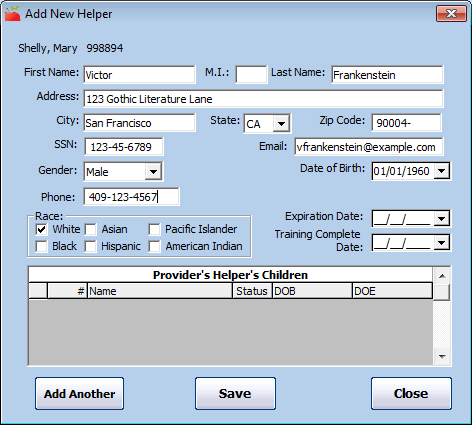
-
Click the Email box and enter the helper's email address.
-
Click the Gender drop-down menu and select the helper's sex.
-
Click the Phone box and enter the helper's phone number.
-
In the Race section, check the box next to each item that applies.
-
Click the Expiration Date and enter the date on which the helper either needs more training or re-certification. This is useful if you require documentation proving that the helper has received training or has appropriate certifications.
-
Click the Training Date Complete box and enter the date the training completed training, if needed.
-
Click Save.
-
Click Add Another to add another helper, or click Close.
Changing Provider Helpers
To update provider helper information:
-
Click the Tools menu and select Provider Helpers. The List Helpers window opens.
-
Click the Provider drop-down menu and select the provider for whom to manage helpers. The helpers created for this provider display.
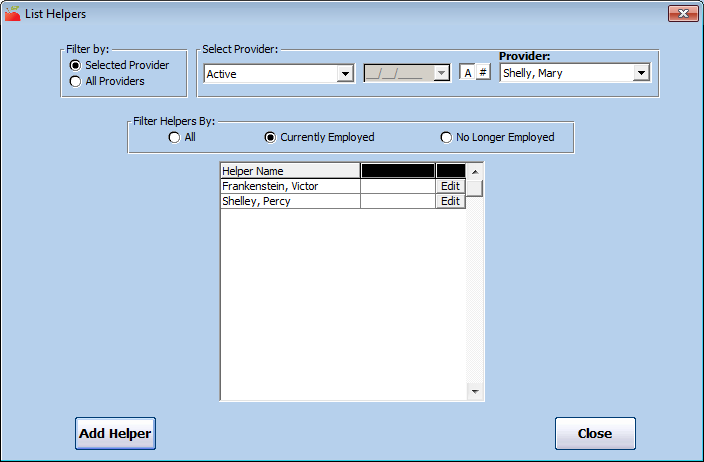
-
In the Filter Helpers By section, select All, Currently Employed, or No Longer Employed.
-
Click Edit next to the helper to change. The Edit Helper Information dialog box opens.
-
Update the helper's information, as needed.
-
If this helper no longer works for the provider, click the Last Date Employed box and enter the helper's last day of employment.
-
When finished, click Save.
Deleting Provider Helpers
You should only delete helpers if they were entered in error. If the Helper no longer works for the provider, enter a date in the Last Date Employed box.
-
Click the Tools menu and select Provider Helpers. The List Helpers window opens.
-
Click the Provider drop-down menu and select the provider.
-
In the Filter Helpers By section, select All, Currently Employed, or No Longer Employed.
-
Click Edit next to the helper to remove. The Edit Helper Information dialog box opens.
-
Click Delete.
-
Respond to the confirmation prompt.
You can access the List Helpers window from the Provider Information window. To do so, click Helpers (to the right) in the Provider Information window.